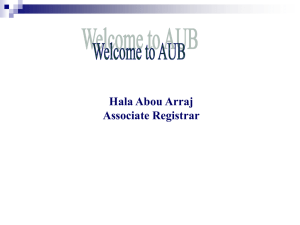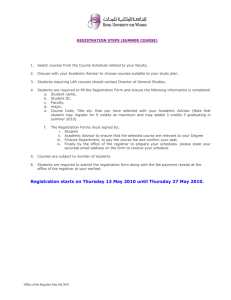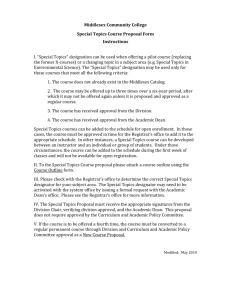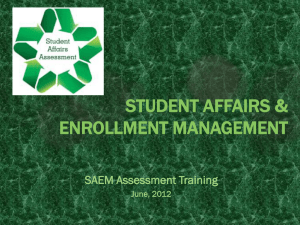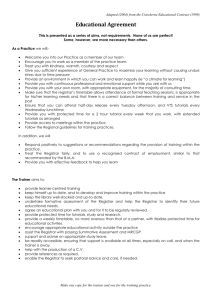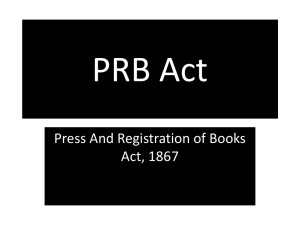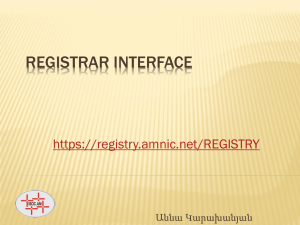Compliance and performance (Word Size 1.33mb)
advertisement
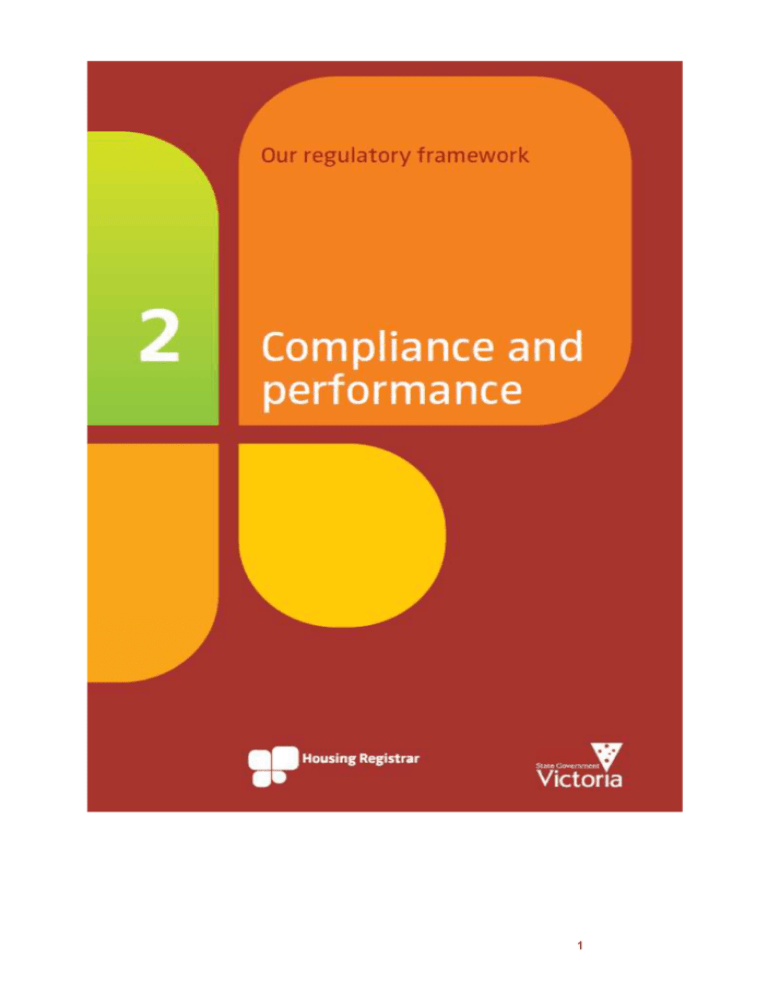
1 Table of Contents 1 Introduction ........................................................................................................................................ 3 2 Legislative compliance and reporting ................................................................................................ 3 2.1 Compliance requirements ........................................................................................................ 4 2.2 Reporting requirements ........................................................................................................... 4 3 Additional reporting requirements ..................................................................................................... 6 4 Key performance measures ................................................................................................................ 7 5 Business plan ...................................................................................................................................... 7 5.1 Content of a business plan ....................................................................................................... 7 5.2 Housing associations – capital development programs ........................................................... 9 6 Business practices – what do we need to see? .................................................................................... 9 6.1 Formal documentation ............................................................................................................. 9 6.2 Processes and systems ............................................................................................................. 9 7 Our assessment focus ....................................................................................................................... 10 8 Our regulatory assessment................................................................................................................ 10 8.1 Annual performance review and financial viability assessment ........................................... 12 8.2 Other related regulatory activity ............................................................................................ 12 8.3 Agency regulatory plan ......................................................................................................... 12 9 Addressing issues from assessment .................................................................................................. 13 Summary ............................................................................................................................................. 14 Published by the Victorian Government Department of Human Services Level 5, 1 Treasury Place, East Melbourne Victoria 3002 Revised October 2009 Also published online at: www.housingregistrar.vic.gov.au © State of Victoria 2009 This publication is copyright. No part may be reproduced by any process except in accordance with the provisions of the Copyright Act 1968. Authorised by the State Government of Victoria Designed by ActualSize 2 1 Introduction Compliance and performance is part of the regulatory framework series. Setting out the responsibilities of both agencies and the regulator, it explains our approach to monitoring and assessment of compliance and performance of registered housing agencies. Our Regulatory Framework provides an overview of how regulation and registration works under the new regulatory system. We now present a series of complementary publications that progress to the next level of detail. Compliance with the financial viability performance standard and assessment of overall agency financial performance is addressed in another publication in the series. Overview of regulatory framework 2 Legislative compliance and reporting Compliance and reporting requirements apply to both categories of registered agencies, but are defined by a risk based approach. The Housing Act 1983 (the Act) created the concept of rental housing agencies that can be either housing associations or housing providers. In practice housing associations are larger, more complex businesses, and companies limited by shares or guarantee. Housing associations have the capacity to undertake initiatives to grow affordable rental housing, using a mix of government funds and private sector investment. Housing providers are essentially 3 valued managers of property. Both categories of registered agency may provide other related services. In essence, the distinction between associations and providers represents a risk based approach at a strategic level. Operationally we apply the same principle to compliance and reporting. Where associations develop in scale over time we have a greater regulatory focus and require a higher level of assurance. 2.1 Compliance requirements Compliance requirements for registered agencies are specified in Part VIII of the Act as follows: S95 A registered agency must comply with relevant Performance Standards S97 (1) A registered agency must establish a complaints procedure S97 (2) A registered agency must take all reasonable steps to resolve a complaint within 30 days of it being made to the agency S97 (3) A registered agency must maintain a register of complaints, and make the register available for inspection by the Registrar S99 (2) A registered agency must co-operate with an investigation conducted in relation to a complaint S100 (3) A registered agency must comply with a Registrar direction to remedy a complaint or take action to reduce likelihood of future complaints S109 (1) A registered agency or former registered agency must not transfer, sell, lease, mortgage, charge or otherwise deal with land in which the Director of Housing (DOH) has an interest – unless the DOH consents in writing or the land is exempt from this section S112-128 relate to the inspection powers of the Registrar S130-131 relate to governing body appointments of an agency based on Registrar recommendation and requirements S132 (8) A registered agency must comply with an instruction from the Registrar relating to agency governance and management Performance Standards require agencies to demonstrate continuous improvement against measures recorded in their annual business plan to Registrar satisfaction. 2.2 Reporting requirements Set out in table 1 are reporting requirements created by the Act. Some requirements are simple data reports, documents or advice an event has occurred. Other requirements - such as reporting of performance against Performance Standards - involve self assessment by an agency. 4 Table 1. Reporting requirements created by the Act. Reporting requirements Notice of change to information recorded in Register of housing agencies (s91) Notice of change to constitution or rules of agency (s102) Operational reports (s104) Annual report (s105) > Performance against Performance Standards > Financial statements and accounts Annual declarations (s106) > Compliance with financial and other reporting requirements of Corporations / Incorporations / Cooperatives Act > Compliance with Australian Tax Office (ATO) requirements > Confirmation that it is not a trustee for any person (other than a registered agency) in relation to any land or other assets (unless prior approval given) > Confirmation that not a subsidiary of any other body other than a registered agency Notification of intention to wind up (s134) > Self generated > In accordance with legal obligation > Commencement of proceedings by any other person Notification of changes to land interests (s108) > Acquisition of interest in land > Land disposal by third party Timeframe Within 14 days To whom? Registrar 28 days in advance of change Registrar Annually in accordance with s105, and at any other time as required by the Registrar Not more than 28 days after annual general meeting (AGM) Registrar Initially at registration, and thereafter not more than 28 days after AGM Registrar At least 28 days Immediately Without Delay Registrar Within 14 days of acquisition Without delay Director of Housing Registrar 5 3 Additional reporting requirements To assist the assessment of compliance and performance and be assured that agencies are well governed, well managed and financially viable, we need to collect additional information on an annual basis. Section 104 of the Act provides us with powers to introduce additional reporting where appropriate. Additional information includes: Complaints summary - summary of complaints managed by the agency for past financial year Business plan achievements self assessment - summary of outcomes achieved against objectives and targets included in the business plan Key performance measures data - statistical return showing results achieved against key performance measures Financial performance report - summary that analyses financial data for the past three financial years and projected data for the next three to fifteen years depending on agency risk category We also require copies of any updated or new key documents and reports that inform us about changes in agency business practices and/or strategic directions. Appendix 1 shows a typical calendar year of regulatory events. A summary of reporting requirements is included in table 2. Table 2 Regulatory inputs from registered agencies Indicator type Examples Annual (August) - Annual (28 days after annual general meeting) >Self assessment of performance against Performance Standards > Audited financial statements & accounts > Declarations >Register updates > Notifications of changes to constitution or rules > Any other reports or information that the Registrar may require on an agency’s operations Occasional (as required) Rationale > Data on results against key performance measures > Self assessment of achievements against objectives and targets in the annual business plan > Annual business plan > Summary of complaints managed by agency >Financial performance report showing historical and projected trends >New or updated versions of policies, procedures and other critical agency business documents > Reports or other evidence of implementation of relevant processes and systems within agency 6 4 Key performance measures We use data on results achieved against key performance measures as part of our assessment of compliance with Performance Standards. Results provide quantitative assurance of agency performance. They provide an indication to us of whether agency current business practices are achieving quality outcomes in administrative operations and service provision. Key performance measures are set out in Appendix 4. No measures have been established for two Performance Standards - Probity and Risk Management. Data on measures is submitted annually. Individual and comparative data contribute to our assessment of compliance with each Performance Standard and overall agency performance. Typically measures identify where: high performance has been achieved potential risks may exist highlighted issues may require further discussion and resolution. If risks are apparent we explore with the agency how it intends to address these. 5 Business plan A good business plan is an essential tool any registered agency is required to have in place. The annual business plan forms a critical component of our monitoring of compliance and performance. The Performance Standards published in the Victorian Government Gazette in August 2005 describe the annual business plan as: One of the principal mechanisms for measuring performance and improvement will be the agency’s annual business plan and the measures of performance contained in that document. The business plan will not be static and the agency will be required to demonstrate continuous improvement against its measures to the satisfaction of the Registrar. We require agencies to provide us with their annual business plan, and any other strategic or corporate planning documents. The annual business plan may be a separate, stand-alone document, or a component of a longerterm strategic plan (generally 3-5 years) the registered agency has in place. It sets out major objectives the registered agency aims to achieve during the year, key initiatives it intends to take, and major targets it aims to reach. The business plan also provides key evidence on an agency’s business and capacity. It must be a real document that is actively owned by the board and the agency as a whole. 5.1 Content of a business plan From a registration and regulatory point of view we would expect a business plan to contain a range of information relative to its size and risk level. In assessing agency business plans, we look for clarity and demonstration the agency understands the business environment in which it operates, identifies the main priorities of a registered agency, and integrates the business plan with the financial performance report. A checklist for larger agencies is shown below. 7 Overall Does the business plan set out the agency’s vision and objectives? Is the business plan coherent and robust? Does it Focus on key organisational objectives, setting out 1. what they are, e.g. growth and/or service improvement? 2. how they will be achieved ? 3. how achievement will be monitored? 4. how responsibilities are identified and managed? Assess the key risks to achieving objectives specifically by identifying key risks addressing how these will be managed given their likelihood and impact and if this is consistent with our knowledge of the key risks the agency faces and its approach to risk management Assess the impact of the environment in which the agency works by identifying key changes in policy key client demands and market opportunities local, regional or national opportunities / threats and if this is consistent with our knowledge and understanding - are there any significant omissions? Demonstrate that it has the financial resources available to meet objectives meet commitments to lenders demonstrate short and long term viability Does the business plan demonstrate linkages to key strategies such as asset management, treasury management etc? What degree of cross subsidisation occurs? Does the business plan demonstrate a commitment to tenants and continuous improvement? The business planning process How does the review of the business plan fit with the agency’s overall business cycle, e.g. budget etc? How have key strategies been properly considered and subsequently built into the business planning process? Governance How does the board effectively provide leadership and ownership of the business plan? How does the board regularly review and monitor the overall achievement / effectiveness of its business plan? What additional skills, resources and governance arrangements does an agency require to achieve the extent and type of growth and diversification as defined in the business plan? 8 5.2 Housing associations – capital development programs A key feature of the business plan of a housing association is its development program, which permeates all areas of business. We would expect to find reference to this activity throughout the business plan, specifically in financial planning, risk management and general agency organisational planning. 6 Business practices – what do we need to see? To remain well managed, well governed, and viable, and continue to meet Performance Standards, it is critical for an agency to demonstrate appropriate business practices are in place. We believe that any well-run and high performing organisation has appropriate business practices in place. Our focus on these arrangements and associated outcomes will not therefore add to the regulatory burden. 6.1 Formal documentation Formal documentation underpins agency operations. It includes policies, procedures, guidelines, plans, and other relevant publications. Such documentation enables board members, management and staff, and other stakeholders to collectively understand the intended approach taken by an agency to all matters concerned with running an organisation and providing services. We gather a comprehensive range of documentation during registration, filed as ongoing evidence of compliance. Further key documents are supplied post registration, added to, modified or updated. Appendix 2 details formal documentation we expect registered agencies to have in place. This formal documentation must exist (or be pending scheduled development) for an agency to be assessed as compliant with a Performance Standard. 6.2 Processes and systems Processes and systems are used by an agency to manage functions and provide feedback on many aspects of its operations. They typically include: information collection and storage tools initiatives and methods used to implement and inform policy and planning, such as: – evaluation and review – surveys and feedback – record keeping and recording – monitoring and reporting. Appendix 3 identifies processes and systems we expect agencies to have in place and provides examples of evidence agencies might supply to demonstrate their existence. We first collect evidence key processes and systems are in place at the point of registration. We add to this initial documentation as significant changes or new developments occur during the normal course of regulatory engagement with registered agencies. Agencies may also provide copies of relevant information to us during their annual reporting. 9 7 Our assessment focus Agency performance is recognised as a combination of compliance and continuous improvement. Our regulatory focus is on both compliance and performance. Agency compliance is established by: meeting specified legislative requirements / timeframes (set out in Section 2) meeting minimal levels of performance for key measures demonstrating sound business practice. Continuous improvement is demonstrated by: positive trends in results against key measures achievement of significant proportion of business plan objectives and targets. Our monitoring and assessment of the above includes relevant differentiation between housing associations and housing providers. Performance = compliance + continuous improvement 8 Our regulatory assessment The annual regulatory review is the major regulatory activity we undertake with registered housing agencies. Undertaken annually following receipt of reporting requirements, the review focuses on the financial year ended on the previous 30 June. The review formally commences after annual reporting documentation is received from an agency. The outcomes of the annual regulatory review provide the foundation for developing the next agency regulatory plan. This plan describes monitoring arrangements and engagement between the agency and ourselves for the calendar year just commenced. 10 During the annual regulatory review, agencies must demonstrate the following: compliance with Performance Standards compliance with other legislative and regulatory requirements achievement and continuous improvement, in particular against our key performance measures, and other measures contained in the agency’s annual business plan. Assessment criteria are set out in Table 3. Table 3 Compliance and assessment criteria Agency performance Compliance with Performance Standards Compliance with other legislative and regulatory requirements Achievement and continuous improvement Our assessment criteria > Have sound agency business practices been demonstrated via: - existence / development of relevant documentation? - evidence relevant processes and practices are in place? > Have minimum levels of performance been met as demonstrated via: - data submitted for results against key performance measures? - financial performance report? > Has agency self assessment submitted as part of annual reporting requirements (due 28 days after annual general meeting) confirmed compliance? >Have any significant issues been identified in information received from an agency during the past year (and in some cases acted upon) as part of regulatory engagement? >Have any issues been identified in information received from other Office of Housing / Department of Human Services (DHS) business units (for example): - findings from reviews conducted under DHS Monitoring Framework? - updates on capital projects progress? - updates on status of lease agreements and meeting of obligations under these? >Have annual reporting documents, declarations, and other regulatory inputs from an agency been submitted in required formats within specified timeframes? > Have updates to the online Register, and notifications of changes to constitutions, rules or functions of the agency been submitted within specified timeframes? > Complaints procedures: – do we have copies of an agency’s complaints procedure? – evidence a complaints register is in place? – any data from the agency and OOH Housing Appeals and Complaints Management Office indicating an agency’s complaints process is effective? > Has any periodic audit conducted by us of an agency’s Register details in the past financial year confirmed an agency is keeping it current? > Has any direction, instruction, or recommendation from us been implemented? >Have results for key performance measures shown positive trends from previous years’ data and/or do they compare favourably with the sector as a whole? > Has the self assessment report of achievements against objectives and targets in the previous year’s business plan indicated that a majority have been met, and provided sound explanations? > Have any major issues or concerns from the past financial year been addressed in targets and objectives in the current year’s business plan? 11 8.1 Annual performance review and financial viability assessment The annual regulatory review comprises two supplementary activities: annual performance improvement review annual financial viability assessment Annual performance improvement review The first round of reporting requirements focuses more upon performance of an agency over the previous year. We incorporate findings from the review of reports submitted in our report describing the outcomes of the annual regulatory review. Annual financial viability assessment Each year this assessment is conducted following receipt of the audited annual accounts and the financial performance report within 28 days of an agency’s annual general meeting. We incorporate findings and recommendations from this assessment in the final report of the annual regulatory review. 8.2 Other related regulatory activity Agencies must ensure all information contained in the Agency Register is updated in a timely and responsive manner. We audit the Register periodically to ensure it is properly maintained. Results also inform the annual regulatory review. To further consolidate our regulatory approach we will introduce themed activity reviewing a specific business practice, for example tenant participation, across all (or a suitable sample of) registered agencies. 8.3 Agency regulatory plan We develop an agency regulatory plan annually with each registered agency. The Plan is a brief summary of planned engagement between the Housing Registrar and registered agency. Its content is closely associated with findings contained in the annual regulatory review report. Developed on a calendar year basis, the agency regulatory plan is not available for an agency until an annual review report is completed. Figure 3 provides a summary of how our key regulatory assessment activities flow into the agency regulatory plan. We consider outcomes from the agency regulatory plan in the annual regulatory review undertaken at the end of the year to which the plan applies. 12 9 Addressing issues from assessment We take issues identified in assessments seriously, and seek to address these as quickly as possible. Our first course of action in discussion with the registered agency is to ensure understanding of the issue is accurate and comprehensive. We seek a collaborative approach to resolving the issue in a timely and logical manner, taking account of an agency’s ability and willingness to remedy an issue. Mostly, we expect resolution to be achieved quickly and effectively. Where an issue is more significant and/or the remedy strategic, we may seek specific undertakings that require action to be taken and included in the annual regulatory plan. When unhappy with agency progress in resolving an issue, we inform an agency and clarify expectations. Where additional reporting by an agency on progress made is considered useful, we specify and implement this reporting requirement with the agency. We may use intervention powers under the Act where we believe an agency is unwilling or unable to deal with significant issues in a satisfactory way. Further information on powers and our use is available in the Intervention Guidelines published in the Victorian Government Gazette in August 2005. In addition, a document focusing on intervention is part of our regulatory framework series. 13 Summary Registration is not time limited. It is dependent upon ongoing compliance with Performance Standards and legislative requirements. Compliance is not the only aspect we monitor to assure ourselves an agency is meeting regulatory obligations. Demonstration of continuous improvement is the other key feature we look for in registered agencies. A range of reports is received from each registered agency. This enables us to undertake regulatory activities to assure ourselves of agency compliance and continuous improvement. We regularly review and streamline our regulatory activities, reports, and outputs produced to ensure: we can make sound regulatory judgements an appropriate balance between receipt of material and unwarranted, onerous reporting is achieved agencies are not burdened unnecessarily. Agency compliance and continuous improvement is expected to translate into positive outcomes for tenants, agencies and other stakeholders. We will identify indicators in the future to monitor outcomes, and adapt our approach accordingly where expectations are not met. 14 15 Appendix 2 Registered housing agency business practice – formal documentation This table summarises documentation the Housing Registrar expects to exist in any registered agency, and reviews as part of the assessment of an agency’s compliance with Performance Standards. The range and volume of separate documents should reflect the scale and complexity of agency business. 16 17 Appendix 3 Registered housing agency business practice – processes and systems This table summaries types of evidence that an agency may forward to the Housing Registrar or be requested to submit at points in time (including during registration) to demonstrate that processes and systems expected to be in place are there and working effectively. 18 19 20 21 22 Appendix 4 Key performance measures 23 24 For more information please contact: Housing Registrar Level 5, 1 Treasury Place, Melbourne Victoria GPO Box 4379, Melbourne VIC 3001 Phone: +61 3 9651 1402 Email: housingregistrar@dtf.vic.gov.au www.housingregistrar.vic.gov.au 25
